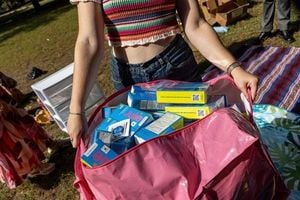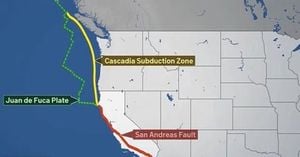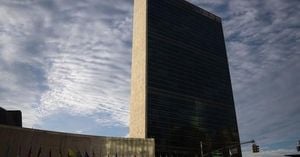In a landmark operation that underscores the growing menace of illegal gold mining in South America, Peruvian customs officials seized a staggering four metric tons of mercury in June 2025, marking the largest such confiscation ever recorded in the Amazon region. The shipment, cleverly disguised as gravel-filled bags and destined for Bolivia, was intercepted at the port of Callao, revealing a sophisticated cross-border smuggling network that fuels one of the most destructive criminal economies in the Amazon basin.
According to Jorge Gallo Alvarado, head of customs enforcement at SUNAT, Peru's tax and customs agency, the cargo was initially labeled as crushed stone but was found to be laced with mercury, a highly toxic substance used in illegal alluvial gold mining. "We could determine that mercury was being transported in its natural state, camouflaged in shipments of gravel," SUNAT officials explained. This detection was the result of advanced risk analysis and material testing, with U.S. specialists confirming the presence of mercury embedded within the gravel—an increasingly common tactic traffickers use to evade detection at formal customs checkpoints.
The seized mercury is valued at approximately $500,000, yet its potential impact is far greater. Luis Fernandez, a mercury expert and research professor at Wake Forest University, who traveled to Lima to assess the find, highlighted its significance: "We don’t often see mercury seizures at this scale, especially not in transit through formal customs points." Fernandez estimated that the mercury could have been used to produce roughly 1,600 kilograms (3,527 pounds) of gold, worth over $172 million at current market prices. "This isn’t subsistence mining," he noted. "It’s organized, high-value illicit trade with serious environmental and public health consequences."
Mercury plays a critical role in artisanal and small-scale gold mining operations across the Amazon. Miners use mercury to extract gold from riverbank sediments through a process called amalgamation, where mercury binds with gold particles to form an amalgam. This amalgam is then heated to vaporize the mercury, leaving behind pure gold. However, this process releases toxic mercury vapors into the atmosphere and contaminates local waterways, where mercury transforms into methylmercury—a potent neurotoxin that accumulates in fish and aquatic life. The contamination has dire consequences for Indigenous and riverine communities that rely on fish as a dietary staple, with mercury detected in drinking water, fish, and even breast milk in Peru’s Madre de Dios region. Long-term exposure can cause irreversible damage to the brain and nervous system, particularly in children and pregnant women.
The Environmental Investigation Agency (EIA), a Washington-based nonprofit watchdog, played a pivotal role in alerting Peruvian authorities to the illicit shipment. Their investigation revealed that at least 200 tons of mercury have been smuggled from Mexico to Bolivia, Colombia, and Peru between April 2019 and June 2025, fueling an estimated $8 billion in illegal gold production. The latest seizure alone represents a significant blow to these trafficking networks, which have become increasingly sophisticated in their methods.
Much of the mercury originates from Mexican mines, particularly in central states like Querétaro. The EIA's recent report highlights an alarming surge in illegal mercury production in Mexico since early 2025, driven by soaring global demand and prices. Mercury prices have reached a record $330 per kilogram, while gold prices have surged 28.5% in 2025 alone, hitting a historic high of $3,500 per troy ounce in April. This price spike has intensified the illicit trade, making mercury smuggling a lucrative enterprise for organized crime groups.
Indeed, the EIA’s investigation uncovers a troubling “gold-mercury-drug trifecta,” linking illegal gold mining to transnational criminal networks. Groups such as Mexico’s Jalisco New Generation Cartel have been implicated in mercury mining and trafficking, while in Colombia, armed factions like the National Liberation Army and the Gulf Clan are deeply involved in the mercury-for-gold trade. These organizations use false documentation and front companies to disguise shipments, allowing mercury to slip through customs and reach illegal mining camps, often located within protected forests or Indigenous territories. Once there, tracing the metal becomes nearly impossible.
Peru ratified the Minamata Convention on Mercury in 2013, an international treaty aimed at reducing mercury emissions and trade. However, enforcement has struggled to keep pace with the agility of trafficking networks. Fernandez emphasized, "These networks are agile. As gold prices rise, they adapt quickly. Customs authorities need tools, training, and resources to keep pace." Adam Dolezal, extractive industries campaigner at EIA, underscored that enforcement alone will not suffice: "Unless mercury production is shut down at the source, this toxic trade will continue." The upcoming Conference of the Parties to the Minamata Convention later this year is expected to prioritize closing legal loopholes that allow mercury to be traded for small-scale mining, aiming to stifle the supply chain at its origin.
The environmental and social consequences of this illicit trade are profound. Mercury contamination devastates ecosystems and endangers human health, while the illegal gold mining boom has fueled violent conflicts in mining regions from West Africa to Peru. Reports detail deadly encounters over territorial control, exploitation of vulnerable communities, and the entrenchment of criminal organizations profiting from this underground economy.
Addressing this crisis requires a multifaceted approach. Strengthening border controls and inspection capabilities with advanced detection technology, expanding international cooperation and agreements, and investing in alternative livelihoods for artisanal miners are critical steps. Moreover, promoting mercury-free gold extraction methods and formalizing artisanal mining operations where feasible can help reduce dependence on mercury. However, these solutions demand sustained political will, resources, and community engagement.
Peru’s record seizure of mercury not only disrupts a significant shipment but also shines a light on the complex web of environmental degradation, public health risks, and organized crime entwined with illegal gold mining. It serves as a stark reminder that combating this crisis requires coordinated global action, innovative enforcement strategies, and support for sustainable economic alternatives in vulnerable communities.





